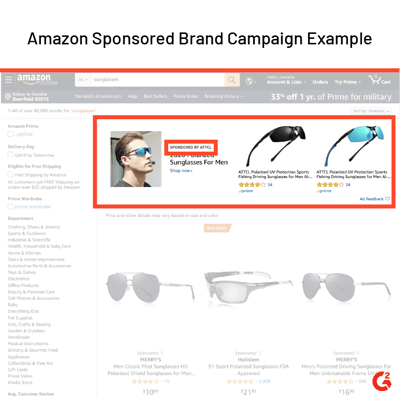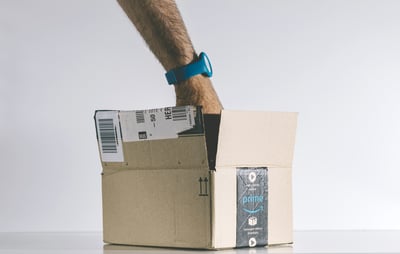November 11, 2019
 by Daniella Alscher / November 11, 2019
by Daniella Alscher / November 11, 2019

An advertiser’s story often begins with having a product that needs to be sold, and organic marketing alone often doesn’t do the trick.
You want to go bigger. You want to do better.
If you’re selling a product online, choosing to advertise on the top e-commerce website in the world might get you the attention you’re seeking.
Amazon has more than 310 million active customers, all looking to buy something. Choosing not to advertise your product to those customers could be a huge missed opportunity.
Just like advertising on any other digital platform, advertising on Amazon should be done to catch the eyes of your target audience, attract them to your product, and, ultimately, turn the right people into your own customers.
Below, we’ll go over all the different ways that advertisers like you can showcase products on the e-commerce platform and the best practices for each placement.
If you’re able to sell on Amazon, you’re able to advertise, too. Below, we’ll become familiar with the different ways that you can advertise the products you’re selling.
| Note: While these ads are easy to set up, they’re not for everyone. Be sure that you know your customer profile and appropriate keywords while targeting. Finally, Amazon does not allow advertising of adult products, used products, refurbished products, or products in closed categories. |
Displayed on mobile and desktop, Amazon Sponsored Product ads can appear on the right side of search results, on the bottom of search results, and on the product details pages. Sponsored Product Ads are helpful for attracting target shoppers because of their keyword targeting abilities.

Product ads are set up similarly to paid search ads on Google. Based on a pay-per-click, keyword targeted system, your product will appear at the top of Amazon’s results when someone enters the keywords you and your team have chosen to target.
Sponsored Product ads allow for automatic keyword targeting, courtesy of Amazon, in which an algorithm helps you choose the most relevant keywords for your product.
If you choose to manually target your keywords, you and your team are able to target three types of keywords.
Broad keywords mean that users can include words before and after your keyword, and your ad will still gain exposure. For example, if your keyword is “mouse pad”, a user searching for “large mouse pad” will still see your advertisement because it contains the keyword “mouse pad” in the query. Targeting broad keywords gives your product maximum exposure.
Phrase keywords focuses on the sequence of words that you use and how that changes the context of the user’s query. For example, “mouse pad” implies to a used that you’re selling...a mouse pad. But “pad grey mouse” may indicate a sort of stuffed animal or decoration (I’m not sure who would be entering this query).
Exact keywords are the most targeted keywords. If the user’s query doesn’t exactly match your keyword “mouse pad” because the words are either out of order or surrounded by additional words, your ad won’t show up.
Advertisers are given the ability to set the duration of their advertisement as well as the daily budget. Campaigns need to run for at least one day, but can be paused at any time.
Sponsored Product ads on Amazon cost as much as you and your team have budgeted for when a shopper clicks on your product. The more competitive your bid is, the more likely your ad will be displayed when it matches a customer’s search intent. You will not be charged for the amount of times your advertisement is displayed; you will be charged per click of your displayed ad.
No matter what product you’re advertising, here are some of the best practices when using Amazon Sponsored Product ads:
Amazon’s Sponsored Brand Campaigns allow advertisers to promote multiple products and their overall brand in one place.

Sponsored Brand Campaigns are designed so that when a shopper clicks on your logo, they’re directed to your brand’s custom landing page. If they choose to click on a product within that banner instead, they’re directed to the product’s page.
Brand Campaigns help drive engagement with your brand as buyers research for the best options on Amazon. Ads are displayed on top of, next to, or within search results on both desktop and mobile.
Again, you’ll be required to choose the most relevant keywords for your brand and your products as well as the amount you’re willing to bid. Remember that there are millions of sellers on Amazon; while being cheap is always an option, it might not give you a real bang for your buck.
Using Brand Campaigns means creating a custom landing page with Amazon, designed around your brand and the products that you’re selling. Building a creative experience means showcasing your products with more than just an image: videos, image galleries, and other features are available. Taking advantage of these features means that you’ll be providing the best experience possible for those who choose to click on your ad. The better the experience you give, the more likely you’ll be getting ROI.
Sponsored Brand Campaigns are based on a cost-per-click system, similar to Sponsored Product ads. The more competitively you bid, the higher chance that your ad will be displayed when it matches the shopper’s search intent.
With Sponsored Brand Campaigns, you’re getting more than just a product image and description: it’s a chance to market your entire brand. Therefore:
Amazon Sponsored Display is available for sellers enrolled in the Amazon Brand Registry, vendors, and advertising agencies that have clients who sell their products on Amazon. Products sold must fall within Amazon’s guidelines.
Sponsored Display uses automation and machine learning to optimize your campaign. By having the ability to display both on and off of the Amazon platform, Sponsored Display gives advertisers the best of both worlds. Creative assets are automatically generated by Amazon to have the look and feel of the ecommerce giant to ensure that viewers can immediately recognize where your product is being sold.

Source: Amazon
Sponsored Display helps advertisers generate creative assets that have the look and feel of Amazon and keep things familiar among viewers. Amazon Sponsored Display ads can be displayed both on Amazon as well as third-party publishers, depending on the targets you choose. When users click your advertisement, they’ll be directed to your product’s page on Amazon.
Sponsored Display allows advertisers to add a list of products they’d like to see advertised online. Sponsored Display will learn and actively promote the products that have the highest chance of conversion.
Sponsored Display ads are CPC based advertisements. Ads will display at no charge to the advertiser until a user chooses to click on your ad. Advertisers are able to choose their own budget, and no minimum advertising investment is required.
Below are some of the ways that Amazon Sponsored Display ads can be used most effectively:
Amazon offers quite a few ways to display your product and brand, and there’s no right option – only a right way of executing your choice. Be sure to do your research thoroughly, follow best practices, and watch your clicks roll right in.
Looking for more Amazon knowledge?
Daniella Alscher is a Brand Designer for G2. When she's not reading or writing, she's spending time with her dog, watching a true crime documentary on Netflix, or trying to learn something completely new. (she/her/hers)
Have you ever thought of using split testing to boost the performance of your content...
 by Bill Acholla
by Bill Acholla
More than 140,000 third-party sellers made more than $100,000 in yearly sales this year.
 by Deirdre O'Donoghue
by Deirdre O'Donoghue
Have you ever thought of using split testing to boost the performance of your content...
 by Bill Acholla
by Bill Acholla


